3D Snow Creation Tips by Bertrand Benoit
Following Bertrands great 3d recreation of the Bauhaus School at Dessau, I got that many request to post more detail about the snowy image he made in that set. Bertrand kindly agreed to write about the process of making his snowy scene, and Im happy to publish his 5 tips for handling snow in an architectural visualization 3d scene. Enjoy!
Bertrand participated in the GH House Challenge, winning the Grand Prize Award for his “Norwegian Lake Shore” entry and as a Judge in the HOVER challenge. He is one of the most talented 3d Architectural Visualization artists that I know of to date. Check out the Interview with Bertrand and his blog at http://bbb3viz.com/ for more information that he posts from time to time.
Introduction
Snowy scenes are a CG favorite, and there are many ways to make a realistic winter image, most of them pretty work intensive. The Bauhaus at Dessau winter scene, my first relatively large-scale snow scene at 12 million polys, was a bit of a learning exercise, and I ended up resorting to a patchwork of approaches gleaned from other CG artists and from my own experiments. Here are a few things I learned on the way summed into 5 tips.
1. Only detail what is seen in the cameras.
This is more of a general CG rule, though not one I’m very good at following myself as I like to improvise my camera placement once I’m finished modeling and texturing. Nevertheless, it’s a good rule to follow for Winter scenes, which typically involve RAM-intensive devices, such as displacement. In addition, snowy surfaces only need to be detailed when seen up close and can become far more simple as they recede in the distance or when seen in reflections.
The image above shows how the displaced surfaces were contained within the camera’s angle. You can see how the level of detail falls further away from the camera as more distant snow surfaces become simple white planes.
2. Displacement is all about the maps.
Displacement can be coarse or fine, depending on the quality of your map. Doing this piece, I learnt that one should not try to save on texture details for those parts of the image that are in focus. The tire marks and foot prints on the road surface close to the camera are obtained with an 8k, hand-painted image. A crop from it is shown below.
For these, I used custom brushes done from a very large number of googled winter images. See how the area immediately surrounding a print are slightly whiter, which translates into a slight bulge in the snow around the print.
Before painting, it’s well worth studying snowy street photographs and reflect about how some effects such as this slight bulge around footprints can be obtained with a map. Make sure you start from a 50 per cent grey map, not an all-white or all-black map. That way you can both add depressions and volume by painting details in black or white. Once you have sculpted the details, go once over your piece once again with a large, fuzzy white brush set to screen and highlight broad, low-frequency areas of the map you want to protrude more. Paint in layers so that you can tune the weight of a particular effect.
Lastly, make sure you paint in 16 bit to avoid sharp gradients (the so-called stairway effect) in your displacement.
3. Snow is not white.
This is especially true when working on areas where the snow has been walked over or moved, or where it would have been sprinkled with grit. When doing tire marks, think of what the surface below would be like. Even clean snow should not be white but light grey.
In this case I used some layers of the displacement map as an opacity mask to mix a sandy-ground map (dirty bits) with a light grey map (clean bits).
4. For modeling, just use what works.
One thing I learnt is that there is no universal recipe for modeling snow. Large expanses of snow can be displaced planes. Snow on steps works well when poly modeled and tweaked using 3dsmax’s freeform tools. Snow on complex surfaces such as trees and balcony railings can be done very nicely and efficiently using the SnowFlow Script.
For the mounds of shoveled snow at the side of the road, I used very simple geometry as seen in the image below.
This was then subdivided and roughly displaced within 3dsmax using a displace modifier.
Only to be displaced again in VRay at render time using the VRayDisplacement modifier. This two-step displacement technique allows a balanced mix of low-frequency volumes with micro-details on surfaces using the same displacement map.
5. It does not have to be SSS
Small amounts of snow on trees and walls looks better when done with an SSS material. But when experimenting, I realized a more contrasty material sometimes looked better on the ground, giving displaced surfaces more definition not to mention that it is much faster to render than SSS. The ground snow on my Bauhaus image is a very basic, pure diffuse material. Here it is below from wire to render, and some actual size crops too.
And the crops
You are welcome to comment on this article and ask questions using the comment box below!


























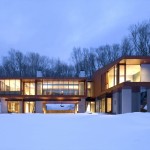
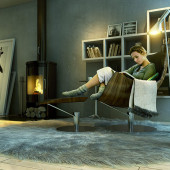
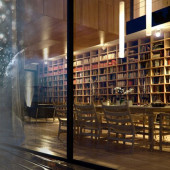
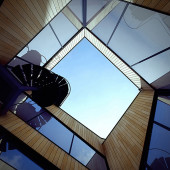
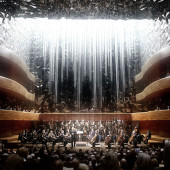
wow, thanks Guys! That’s really great tut – surely to use Your tips asap =)
keep pushing the boundaries!
Awesome. Thank you!
Thanks for that!
Nice making, Bertrand is for my one of the best CG artist worldwide. Each time he’s got more and more impressive renders.
I have just one question, which I think has a simple answer.
When painting the displacement map, how do you know you are painting details in the correct place?
Are you unwrapping the road? Or rendering out a top view?
If rendering a top view, are the extents of the camera limited to the road?
Otherwise, excellent tips.
As always Bertrand, a pure joy to read your instructions. It definitely inspires me to try a snow scene for myself sometime soon.
Thanks for sharing tips so freely.
Great image! I have a few questions,
Did you actually use a VRayDisplacementModifier, or just displace in material slot? What was the resolution of Displace map? And what was the render time of final image.
Thanks a lot for sharing.
Great work!!
How much days of work for obtain the final image?
Thanks for the tips.
Hi Bertrand,
Thanks for such a great contribution to the 3d community. You are briging to the archviz field techniques which are used on some of the best special fx for movies.
Congrats for so many great pieces.
Question: How did you do the DOF in the Bauhaus renderings? Post production or Vray?
Thanks!
Many thanks to Ronen and his great blog too. This blog keeps getting better and better! 🙂
Very glad you guys could find some use for these tips.
Dave: I did unwrap the road and render a UV Layout before painting. You can also use an isometric render, as an additional, especially if you need to paint around objects. Or you can render an ambient occlusion pass to the texture.
Cherkio: I used the VrayDisplacement modifier, which gives more control, and the displacement map was 8k. (The diffuse map can be much smaller, in this case 4k).
Petrusand: This one, including the summer shots, took about a month, on and off.
Christian: For stills, I always use in-render DOF. It’s much more accurate, especially for objects located in front of the focus field. Having said that, although DOF is always set to on on my camera, there shouldn’t be any noticeable DOF in this particular image because the lense is so wide.
Really nice work. (One time again)
thanks for share.
Yann
Bertrand, an amazing job.
Thanks for sharing.
Regards.
Hi Bertrand,
Unless it´s the AA filter, I can see a slight difference in the softness of the edges from the foreground to the background parts of the building. In my point of view, that´s one of the several reasons why your image looks very photorealistic.
I wonder if you like to render larger landscapes…With so many techniques that you have developed and used, Large natural scenes, very detailed matte paintings…You have lots of potential to do that. Just a suggestion.
Keep up the great work!
Bertrand, You are amazing!
Have you ever thought of going into the field of architecture? Judging by you Hover submission and your line of 3d furniture you have a good eye for form and space. You should look into it.
Is the one map used for the whole snow or have you chopped it into several maps? As you said – nearer areas need more detail than the further ones. I myself when making grass textures with UV that won’t repeat am asking myself – to make smaller parts which will texture separately or just make larger texture?
Un-Fing-Believable. Let me rephrase that… it is absolutely BELIEVABLE. Awesome job, I have a fire lit to go back to a few of my models and try the snow out. Cheers!
Thanks for the feedback, guys.
Sandking: It’s one large 8k map, but it’s mirrored once roughly where you see the staircase.
Very nice! cool displacement maps 😛
I still have to ask though, on what do you base your claim that snow is not white? I´m not talking in scientific terms here, but from a practical point of view. In a setting such as yours the snow, unless it´s all dirty (ok to be fair this DOES look like the dirty, melting snow we get in march and april), should be way brighter than the walls of the building, thus forcing you to lower your exposure.. just a thought 🙂
please tell us about setup rendering ..
certainly color mapping..
i want to know how you can reach this mood and colors
i usually use reinhard but still cant achive live colors ..
please help me ;(
OMG thats so fucking amazing!